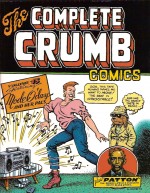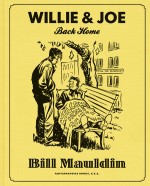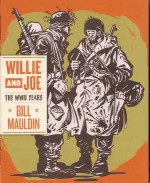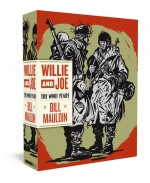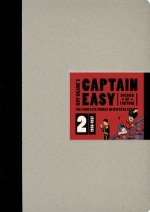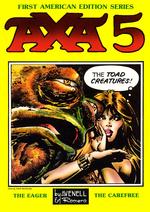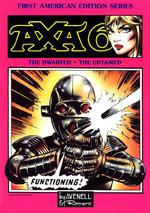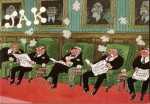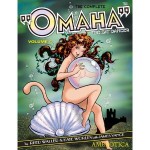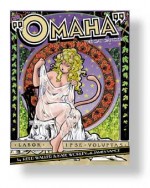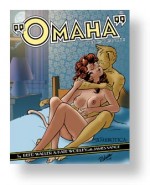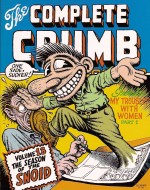
By Robert Crumb and others (Fantagraphics Books)
ISBN: 978-1-56097-296-9
Like crisps, chocolate and bad puns; once you get the taste of Robert Crumb on your palate, it’s almost impossible to shift the craving for more. Here’s another re-released edition from the superb and multi-award winning Complete Crumb Comics series that will tickle the bad-taste-buds of discerning comics cognoscenti and is bound to make a whole new generation of fans among the cool kids who will take my usual disclaimer in the full spirit which it is intended.
This book contains really clever and outrageously dirty pictures, rude words, non-condemnatory drug references and allusions, godless questioning of authority and brilliantly illustrated. highly moving personal accounts and opinions. If you – or those legally responsible for you – have a problem with that, please skip this review and don’t buy the book. That will certainly teach us…
Robert Crumb is a unique creative force in the world of comics and cartooning with as many detractors as devotees. His uncompromising, excoriating, neurotic introspections, his pictorial rants and invectives, unceasingly picked away at societal scabs and peeked behind forbidden curtains for his own benefit, but he has always happily shared his unwholesome discoveries with anybody who takes the time to look… In 1987 Fantagraphics Books began the nigh-impossible task of collating, collecting and publishing the chronological totality of the artist’s vast output and those mesmeric volumes are now being reissued.
The son of a career soldier, Robert Dennis Crumb was born in Philadelphia in 1943, into a functionally broken family. He was one of five kids who all found different ways to escape their parents’ highly volatile problems and comic strips were paramount among them.
As had his older brother Charles, Robert immersed himself in the comics and cartoons of the day; not just reading but creating his own. Harvey Kurtzman, Carl Barks and John Stanley were particularly influential, but also strip artists such as E.C. Segar, Gene Ahern, Rube Goldberg, Bud (Mutt and Jeff) Fisher, Billy (Barney Google), De Beck, George (Sad Sack) Baker and Sidney (The Gumps) Smith as well as illustrators like C.E. Brock and the wildly imaginative and surreal 1930’s Looney Tunes and Merrie Melodies animated shorts.
Defensive and introspective, young Robert pursued art and self-control through religion with equal desperation. His early spiritual repression and flagrant, hubristic celibacy warred with his body’s growing needs…
Escaping his stormy early life, he married young and began working in-house at the American Greeting Cards Company. He discovered like minds in the growing counterculture movement and discovered LSD. In 1967 Crumb relocated to California and became an early star of Underground Commix. As such he found plenty of willing hippie chicks to assuage his fevered mind and hormonal body whilst reinventing the very nature of cartooning with such creations as Mr. Natural, Fritz the Cat, Devil Girl and a host of others.
He worked on in what was essentially a creative utopia throughout the early 1970’s but the alternative lifestyle of the Underground was already dying. Soon it would disappear: dissipated, disillusioned, dropped back “in†or demised. A few truly dedicated publishers and artists stayed the course, publishing on a far more businesslike footing as Crumb carried on creating, splitting his time between personal material and commercial art projects whilst incessantly probing deeper into his turbulent inner world.
After an introduction from his brother Maxon Crumb, this re-issued 13th tome opens with ‘Treasure Island Days’ an autobiographical junket of the young Crumb boys from Lemme Outa Here in 1978, produced in collaboration with brother Charles, after which come the nigh-legendary pieces produced for CoEvolution Quarterly #23-26 in 1979-1980, still powerfully impressive after all these years.
The gently biting ‘A Short History of America’, the subversively salacious ‘Bearzie Wearzies’ as well as the stunning black, white and yellow covers to #24, the wildly manic ‘Bop It Out’ (with a canny cameo from the amazing “No-Shit Sherlockâ€) and the gloriously dry and acerbic fable ‘Adventures of Onionhead’, is followed by the first of a clutch of fabulous American Splendor collaborations with uniquely Ordinary Hero Harvey Pekar in ‘Excerpt’ (from Cleveland Magazine 1980). ‘Me and My Sweetie’ (Portfolio of Underground Art) and the superbly expressionistic cover to Tele Times (vol. 2 #21) end the initial black and white section of the book.
The middle section is full colour and comprises covers and album art; beginning with Bizarre Sex, #8, American Splendor #24 and Snoid Comics, before presenting the rarer (for comics readers at least) material: Blind Boy Fuller: Truckin’ My Blues Away, Banana in Your Fruit Basket, Cheap Suit Serenaders (Crumb’s own Swing nostalgia band), Cheap Suit Party Record, Memphis Jug Band, Yazoo’s History of Jazz, Wild Family Orchestra, a selection of record labels designed by Crumb and Eddie Lange: Jazz Guitar Virtuoso. In addition to these magical concoctions there are also four superb pages of Heroes of the Blues Trading Cards and an Early Jazz Greats poster ad.
The comics section resumes with Crumb’s crudest, most abrasive, confrontational and possibly most cathartic creation: an arrogant, abusive, sex-crazed little homunculus called Mr. Snoid.
Unpleasant and usually unwelcome, Snoid was utterly self-obsessed; a rampaging animate artistic impulse which nevertheless managed to sway or bully those around him into complying with whatever gratuitous flight of the Id he might contemplate or require instant gratification for…
Always his own harshest critic and ever-searching for artistic perfection, it was still hard for even his biggest fans to look at Crumb-the-creator in the same way after the Snoid hit town.
The character debuted in 1980 in – what else – Snoid Comics , grabbing the spotlight from panel one of ‘This Cartooning is Tricky Business’ before declaring his unpleasant manifesto and attitude on everything from art to women in ‘The Snoid Goes Bohemian.’ The most unsavoury origin in comics followed in ‘How Snoids are Born’ after which ‘One Foot to Heaven’ finds the little stinker looking for a little action and ‘Mr. Snoid Among His Fellow Humans’ gives a final insight into his obscenely unique philosophy of life.
As liberating, challenging and guiltily, wrongly funny as Snoid was, his creation – or perhaps escape – certainly reinvigorated Crumb creative juices, both as auteur and artistic collaborator.
‘Freddy Visits for the Weekend’ and the two strips that comprise ‘Vox Populi’ (drawn for Harvey Pekar’s American Splendor #5) resonate with new vehemence and understated tension, whilst the illustrations for Michael Bloomfield’s ‘Me and Big Joe’ from High Times #64 sparkle with affection and warmth.
‘Hospital Fun’ #1-2, scripted by Pekar, first appeared in Village Voice #25, after which Crumb’s next breakthrough series began in Zap #10, 1982, as the introspective, retrospective autobiographical ‘My Troubles With Women’ shockingly and hilariously opened more doors into Crumb’s troubled soul for us all to peer uncomfortably at…
This incautiously appealing edition ends with a selection of covers, ads and illustrations by Crumb from the ecologically proactive (we would now call it “Greenâ€) Californian magazine Winds of Change (volume 2, #1-9 from 1980-1981) and includes articles by wife Aline Kominsky-Crumb and five of their collaborative strips ‘Everyday Funnies’ before this 13th chronicle closes with a typically effective (unpublished) book cover for ‘King of the Freaks’.
None of these collections is free of potentially offensive material and Crumb’s work is riddled with his often hard-to-embrace obsessive self-exploratory concerns. As always his work gouges out the creator’s most intimate and disturbing idiosyncrasies about women, sex, racial stereotypes, unchecked social change and a million other daily beefs and niggles. But there’s no disparagement intended or harm meant – except perhaps to himself – and his staggering honesty, incisive inquisitiveness and neurotic, intimate over-sharing is always leavened with a devastatingly ironic wit and rendered in imagery too powerful to ignore. Be warned but please don’t misunderstand what you’re looking at…
Crumb’s sublime cartooning has brought cachet and serious critical thought to our once ghettoised art form and, love or loathe him, no one can diminish his contribution to the broad world of graphic narrative. These superb books are the perfect introduction to any (definitively over 18) newcomers unaware of grown up comics… so if you are intrigued snatch up this book and all the others as soon as conceivably possible…
All material from American Splendor © 1980, 1998 Harvey Pekar & R.Crumb. All other material © 1976, 1978, 1979, 1980, 1981, 1998, 2011 R. Crumb. All rights reserved.

